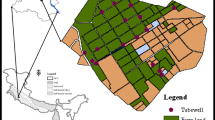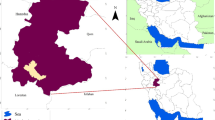Abstract
Over the last several decades, increased groundwater usage by agriculture with a consequence of groundwater resource depletion has motivated the discussion of sustainability of groundwater resource. In this study, to investigate the impacts of agricultural best management practices (BMPs) on groundwater level, two kinds of conservation practices and five scenarios of tail water recovery pond and crop rotation were simulated by various groundwater recharge and pumping plans in Soil and Water Assessment Tool (SWAT) and MODFLOW models in an agriculture watershed in Mississippi, U.S.. The calibrated and validated ground water model indicated coefficient of determination (R2) of 0.81 and Nash–Sutcliffe model efficiency coefficient (NSE) of 0.79 respectively. The results from this study showed that the groundwater recharge changed with irrigation plans and surface hydrological impact of management practices. In addition, it determined that tail water recovery pond could help mitigate groundwater depletion. The groundwater recharge due to continuous corn crop scenario was 7% higher in average than that of the continuous soybean. Non-growing season groundwater recharge may be critical for groundwater recovery. The average groundwater level was increased continuous corn scenario by 15%, continuous soybean by 13%, and corn-soybean by 14% as compare to the baseline scenario with rice planted. Results of this study can be helpful for planning on how various BMPs impact on groundwater.








Similar content being viewed by others
References
Alley WM, Reilly TE, Franke OL (1999) Sustainability of ground-water resources vol 1186. U.S. Department of the Interior, U.S. Geological Survey, Denver, CO, USA
Anuraga T, Ruiz L, Kumar MM, Sekhar M, Leijnse A (2006) Estimating groundwater recharge using land use and soil data: A case study in South India. Agric Water Manag 84:65–76
Arabi M, Frankenberger JR, Engel BA, Arnold JG (2008) Representation of agricultural conservation practices with SWAT. Hydrol Process 22:3042–3055
Arnold JG, Allen PM, Bernhardt G (1993) A comprehensive surface-groundwater flow model. J Hydrol 142:47–69
Barlow JR, Clark BR (2011) Simulation of water-use conservation scenarios for the Mississippi Delta using an existing regional groundwater flow model vol 2011–5019. U.S. Department of the Interior, U.S. Geological Survey, Reston, VA, USA
Brown GF (1947) Geology and artesian water of the alluvial plain in northwestern Mississippi. Bulletin, vol 65. Mississippi State geological survey, Mississippi State, MS, USA
Bryd BC (2014) Status of Delta water supplies. Yazoo Mississippi Delta Joint Water Management District. http://www.ymd.org/pdfs/deltairrigationmeetings/charlottebyrd.pdf. Accessed May 6 2017
Cheema MJM, Immerzeel WW, Bastiaanssen WGM (2014) Spatial quantification of groundwater abstraction in the irrigated Indus basin Groundwater 52:25–36
Clark BR, Hart RM (2009) The Mississippi embayment regional aquifer study (MERAS): documentation of a groundwater-flow model constructed to assess water availability in the Mississippi embayment vol 2009–5172. U. S, Geological Survey, Reston, VA, USA
Clark BR, Hart RM, Gurdak JJ (2011) Groundwater availability of the Mississippi embayment. U.S. Geological Survey Reston, VA, USA
Clark BR, Westerman DA, Fugitt DT (2013) Enhancements to the Mississippi embayment regional aquifer study (MERAS) groundwater-flow model and simulations of sustainable water-level scenarios. U.S. Geological Survey, Reston, VA, USA
Dakhlalla AO, Parajuli PB, Ouyang Y, Schmitz DW (2016) Evaluating the impacts of crop rotations on groundwater storage and recharge in an agricultural watershed. Agric Water Manag 163:332–343
Dechmi F, Skhiri A (2013) Evaluation of best management practices under intensive irrigation using SWAT model. Agric Water Manag 123:55–64
Dickey EC, Jasa PJ, Shelton DP (1986) Estimating residue cover. U.S. Department of Agriculture, Washington, D.C., USA
Gosain AK, Rao S, Srinivasan R, Reddy NG (2005) Return-flow assessment for irrigation command in the Palleru River basin using SWAT model. Hydrol Process 19:673–682
Guzman J et al. (2013) An integrated hydrologic modeling framework for coupling SWAT with MODFLOW. In: 2012 International SWAT Conference Proceedings, pp 16–20
Harbaugh AW, Banta ER, Hill MC, McDonald MG (2000) MODFLOW-2000, The U. S. Geological Survey Modular Ground-Water Model-User Guide to Modularization Concepts and the Ground-Water Flow Process. U. S. Geological Survey, Reston, VA, USA
Hart RM, Clark BR, Bolyard SE (2008) Digital surfaces and thicknesses of selected Hydrogeologic units within the Mississippi embayment regional aquifer study (MERAS). U.S. Geological Survey Reston, VA, USA
Jayakody P, Parajuli PB, Sassenrath GF, Ouyang Y (2014) Relationships between water table and model simulated ET. Groundwater 52:303–310
Johnson AI (1967) Specific yield: compilation of specific yields for various materials, vol 1662-D. U.S. Government Printing Office, Washington, D.C., USA
Karamouz M, Kerachian R, Zahraie B (2004) Monthly water resources and irrigation planning: case study of conjunctive use of surface and groundwater resources. J Irrig Drain Eng 130:391–402
Kim JH, Jackson RB (2012) A global analysis of groundwater recharge for vegetation, climate, and soils. Vadose Zone J 11
Kim NW, Chung IM, Won YS, Arnold JG (2008) Development and application of the integrated SWAT–MODFLOW model. J Hydrol 356:1–16
Klocke N, Watts DG, Schneekloth J, Davison DR, Todd R, Parkhurst AM (1999) Nitrate leaching in irrigated corn and soybean in a semi-arid climate Transactions of the ASAE 42:1621
Kollet SJ, Maxwell RM (2008) Capturing the influence of groundwater dynamics on land surface processes using an integrated, distributed watershed model. Water Resour Res 44
Logan TJ (1990) Agricultural best management practices and groundwater protection. J Soil Water Conserv 45:201–206
Luo P et al (2019) Water quality trend assessment in Jakarta: A rapidly growing Asian megacity. PloS one 14:e0219009
Lyu J, Mo S, Luo P, Zhou M, Shen B, Nover D (2019) A quantitative assessment of hydrological responses to climate change and human activities at spatiotemporal within a typical catchment on the Loess Plateau. China Quaternary International 527:1–11
Maupin MA, Kenny JF, Hutson SS, Lovelace JK, Barber NL, Linsey KS (2014) Estimated use of water in the United States in 2010 vol circular 1405. U.S. Department of the Interior, U.S. Geological Survey, Reston, VA, USA
Mississippi Agricultural and Forest Experiment Station (MAFES) (2002-2014) Variety trails information bulletin 373–520. Mississippi State University, Mississippi State, MS, USA
Ni X, Parajuli PB (2018) Evaluation of the impacts of BMPs and tailwater recovery system on surface and groundwater using satellite imagery and SWAT reservoir function. Agric Water Manag 210:78–87
Osborn L (2010a) Average annual precipitation by state. Current Results Publishing Ltd. https://www.currentresults.com/Weather/Mississippi/average-mississippi-weather.php. Accessed May 9 2018
Osborn L (2010b) Average annual precipitation by state. Weather Averages for the United States. Current Results Publishing Ltd. https://www.currentresults.com/Weather/US/average-annual-state-precipitation.php. Accessed May 9 2018
Parajuli PB, Jayakody P, Sassenrath GF, Ouyang Y, Pote JW (2013) Assessing the impacts of crop-rotation and tillage on crop yields and sediment yield using a modeling approach. Agric Water Manag 119:32–42
Parajuli PB, Jayakody P, Sassenrath GF, Ouyang Y (2016) Assessing the impacts of climate change and tillage practices on stream flow, crop and sediment yields from the Mississippi River basin. Agric Water Manag 168:112–124
Powers S (2007) Agricultural water use in the Mississippi Delta. In: Mississippi water resource conference, Jackson, MS, USA. Yazoo Mississippi Delta Joint Water Management District,
Rosenthal WD, Srinivasan R, Arnold JG (1995) Alternative river management using a linked GIS-hydrology model Transactions of the ASAE 38:783–790
Scanlon BR, Mace RE, Barrett ME, Smith B (2003) Can we simulate regional groundwater flow in a karst system using equivalent porous media models? Case study, Barton Springs Edwards aquifer, USA. J Hydrol 276:137–158
Scanlon BR, Faunt CC, Longuevergne L, Reedy RC, Alley WM, McGuire VL, McMahon PB (2012) Groundwater depletion and sustainability of irrigation in the US High Plains and Central Valley. Proc Natl Acad Sci 109:9320–9325
Sharma ML (1986) Measurement and prediction of natural groundwater recharge—an overview Journal of Hydrology (New Zealand):49-56
Siebert S, Burke J, Faures J-M, Frenken K, Hoogeveen J, Döll P, Portmann FT (2010) Groundwater use for irrigation–a global inventory. Hydrol Earth Syst Sci 14:1863–1880
Sulis M, Meyerhoff SB, Paniconi C, Maxwell RM, Putti M, Kollet SJ (2010) A comparison of two physics-based numerical models for simulating surface water–groundwater interactions. Adv Water Resour 33:456–467
United States Department of Agiculture NRCS (2011) Natural resources conservation service conservation practice standard, Tailwater Recovery No. Code 447. United States Department of Agiculture, Washington, D.C., USA
United States Department of Agriculture National Agricultural Statistics Service (USDA/NASS) (2009) The Cropland Data Layer
United States Geological Society (USGS) (1999) National elevation dataset. Reston, VA, USA
Wada Y, Van Beek LP, Van Kempen CM, Reckman JW, Vasak S, Bierkens MF (2010) Global depletion of groundwater resources. Geophys Res Lett 37:L20402
White D, Dunin F, Turner N, Ward B, Galbraith J (2002) Water use by contour-planted belts of trees comprised of four Eucalyptus species. Agric Water Manag 53:133–152
Xu X, Huang G, Qu Z, Pereira LS (2011) Using MODFLOW and GIS to assess changes in groundwater dynamics in response to water saving measures in irrigation districts of the upper Yellow River basin. Water Resour Manag 25:2035–2059
Yang Y, Watanabe M, Sakura Y, Changyuan T, Hayashi S (2002) Groundwater-table and recharge changes in the Piedmont region of Taihang Mountain in Gaocheng City and its relation to agricultural water use Water SA 28:171–178
Yang X, Chen Y, Pacenka S, Gao W, Zhang M, Sui P, Steenhuis TS (2015) Recharge and groundwater use in the North China Plain for six irrigated crops for an eleven year period. PloS one 10:e0115269
Yazoo Mississippi Delta Joint Water Management District (2006) Water management plan. Yazoo Mississippi Delta Joint Water Management District. Yazoo, MS, USA
Yazoo Mississippi Delta Joint Water Management District (2002-2010a) Annual report 2002-2010. Yazoo Mississippi Delta joint water Management District, Yazoo, MS, USA
Yazoo Mississippi Delta Joint Water Management District (2002-2010b) Annual water use report 2002-2010. Yazoo Mississippi Delta Joint Water Management District, Yazoo, MS, USA
Zhang Y-K, Schilling K (2006) Effects of land cover on water table, soil moisture, evapotranspiration, and groundwater recharge: a field observation and analysis. J Hydrol 319:328–338
Acknowledgements
We would like to acknowledge the partial financial support of AFRI competitive grant award # 2013-67020-21407, and 2017-67020-26375, from the USDA/NIFA for this project. We would like to acknowledge the support of Yazoo Mississippi Delta Joint Water Management District; USGS; and all our collaborators.
Author information
Authors and Affiliations
Corresponding author
Ethics declarations
Conflict of Interest
None
Additional information
Publisher’s Note
Springer Nature remains neutral with regard to jurisdictional claims in published maps and institutional affiliations.
Electronic supplementary material
ESM 1
(DOCX 23 kb)
Rights and permissions
About this article
Cite this article
Ni, X., Parajuli, P.B. & Ouyang, Y. Assessing Agriculture Conservation Practice Impacts on Groundwater Levels at Watershed Scale. Water Resour Manage 34, 1553–1566 (2020). https://doi.org/10.1007/s11269-020-02526-3
Received:
Accepted:
Published:
Issue Date:
DOI: https://doi.org/10.1007/s11269-020-02526-3




